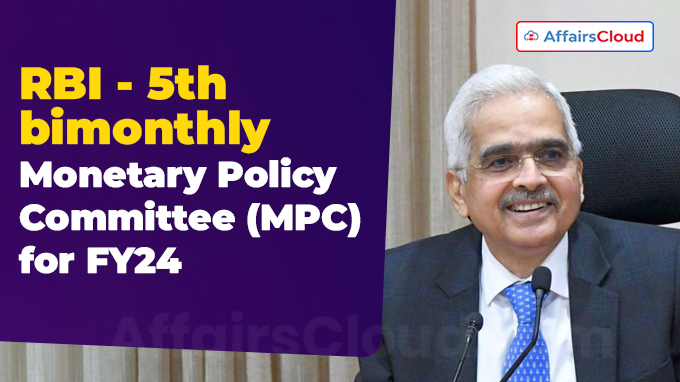 The Reserve Bank of India (RBI)’s 5th Bi-monthly Monetary Policy Committee (MPC), held from 6th to 8th December 2023, has decided to retain the policy repo rate under the liquidity adjustment facility (LAF) unchanged at 6.50% for 5th consecutive time.
The Reserve Bank of India (RBI)’s 5th Bi-monthly Monetary Policy Committee (MPC), held from 6th to 8th December 2023, has decided to retain the policy repo rate under the liquidity adjustment facility (LAF) unchanged at 6.50% for 5th consecutive time.
- The standing deposit facility (SDF) rate is also retained at 6.25% and the marginal standing facility (MSF) rate and the Bank Rate is at 6.75%.
These decisions were in line with the objective of achieving the medium-term target for consumer price index (CPI) inflation of 4% within a band of +/- 2% , while supporting growth.
Members of MPC:
Dr. Shashanka Bhide; Dr. Ashima Goyal; Prof. Jayanth R. Varma; Dr. Rajiv Ranjan; Dr. Michael Debabrata Patra; and headed by Shaktikanta Das (RBI Governor).
- The next meeting of the MPC is scheduled during February 6-8, 2024.
RBI’s Policy Rates:
The MPC kept the policy rates unchanged.
| Category | Rate |
|---|---|
| Policy Repo Rate | 6.50% |
| Fixed Reverse Repo Rate | 3.35% |
| Standing Deposit Facility (SDF) Rate | 6.25% |
| Marginal Standing Facility (MSF) Rate | 6.75% |
| Bank Rate | 6.75% |
| Cash Reserve Ratio (CRR) | 4.50% |
| Statutory Liquidity Ratio (SLR) | 18% |
- RBI kept the repo rate unchanged citing concerns about a possible resurgence in inflation and emphasizing its commitment to price stability.
Real GDP Growth Projections:
RBI has kept India’s real Gross Domestic Product (GDP) growth 7% in FY24 (2023-24) with Q3 at 6.5%, and Q4 at 6%.
- Real GDP growth for Q1FY25 (April-June, 2024-25) is projected at 6.7%, Q2FY25 (July-September, 2024-25) at 6.5%, and Q3FY25 (October-December, 2024-25) at 6.4%.
- The stance is to focus on withdrawal of accommodation to ensure that inflation progressively aligns with the target, while supporting growth.
Note:
It should be noted that the real GDP for FY24 in 4th Bi-Monthly Policy was projected at 6.5%. Now, the rise in this projection to 7% is driven by continued growth in manufacturing, construction, and rural sectors, along with strong bank and corporate balance sheets, normalized supply chains, and rising capital spending, which will drive future investments.
Inflation:
i.Consumer Price Index (CPI) inflation or retail inflation is projected at 5.4% for FY24,with Q3 at 5.6%, and Q4 at 5.2%.
ii.CPI inflation for Q1FY25 is projected at 5.2%, Q2FY25 at 4%, and Q3FY25 at 4.7%.
- This forecast is on the assumption of normal monsoon.
iii.RBI set an objective of achieving the medium-term target for CPI inflation of 4% within a band of +/- 2%, while supporting growth.
iv.CPI headline inflation decreased by about 2 percentage points to 4.9% in October 2023 amid decrease in prices of certain vegetables, deflation in fuel and a broad-based moderation in core inflation (CPI inflation excluding food and fuel).
Domestic & Global Economy:
i.With Respect to the domestic economy, real GDP grew Year-on-Year (Y-o-Y) by 7.6% in Q2FY24 supported by robust investment, government consumption, and offsetting net external demand drag.
- The gross value added (GVA) increased by 7.4% in Q2, led by vibrant manufacturing and construction activities.
ii.With respect to the global economy, the growth is slowing; inflation recedes but remains above target.
- There is positive market shift with lower bond yields, depreciation in USD, and global equities strengthened.
- Emerging markets experience fluctuating capital flows.
RBI increased the limit for e-mandate to Rs 1 lakh per transaction
RBI has increased the cap on e-mandates for recurring online transactions to Rs 1 lakh per transaction from Rs 15,000 currently for following categories:
- Subscription to mutual funds, payment of insurance premium and payments of credit card bills.
Key Points:
i.Under the e-mandate framework, an Additional Factor of Authentication (AFA) is required for recurring transactions exceeding certain limit which now being raised to Rs 1 lakh.
ii.The number of e-mandates registered currently stands at 8.5 crore, processing nearly Rs 2800 crores of transactions per month.
RBI raises UPI transaction limit for hospitals, educational institutions to Rs.5 lakh
To encourage the use of Unified Payments Interface (UPI), for medical and educational services, RBI raises the limit for UPI payments to hospitals and educational institutions from Rs 1 lakh to Rs 5 lakh per transaction.
- This will help people make UPI payments of higher amounts for education and healthcare purposes.
Background:
i.The transaction limit for UPI is capped at Rs 1 lakh, except a few categories like Capital Markets, Collections, Insurance etc. where the transaction limit is Rs 2 lakh, and for payments for Retail Direct Scheme and for IPO (Initial Public Offer) subscriptions, it was Rs 5 lakh.
ii.UPI is a real-time payment system in India that allows seamless, instant transactions between different banks using smartphones.
- It was launched by the National Payments Corporation of India (NPCI) in 2016.
SDF and MSF allowed on Weekends, Holidays
RBI has allowed banks to reverse liquidity facilities under both SDF (standing deposit facility) and MSF (marginal standing facility) on weekends and holidays w.e.f. December 30, 2023.
- Previously, funds moved from SDF to MSF on Fridays and reversed on Mondays; now, reversals will occur over the weekends.
- This move is expected to facilitate better fund management by the banks.
Key Points:
i.SDF is a collateral-free liquidity tool by the RBI to absorb excess liquidity from banks while ensuring they maintain sufficient liquidity.
ii.RBI uses MSF as a mechanism for banks through which they can obtain liquidity overnight if inter-bank liquidity dries up.
RBI to introduce Unified Framework for Connected Lending
RBI will introduce a unified regulatory framework for connected lending for all Regulated Entities (REs) as the current guidelines on the issue are limited in scope and are not applicable uniformly to all regulated entities.
- This decision will reduce the influence of business conglomerates in the Indian lending sector.
- Connected lending means lending to related parties within the same business group.
RBI to introduce Regulatory Framework for WALP
The RBI is also introducing a regulatory framework for web-aggregation of loan products (WALP). WALP offers a service that aggregates loan offers from multiple lenders/ Lending Service Providers (LSPs) on an electronic platform. This allows borrowers to compare offers and choose the most suitable loan option.
- The decision to introduce a framework for the same was taken on the recommendations of the Working Group on Digital Lending chaired by Jayant Kumar Dash.
RBI to establishment Cloud Facility for the Financial Sector in India
RBI proposed to establish a cloud facility for the financial sector in India to enhance security, integrity and privacy of financial sector data along with facilitation of scalability and business continuity.
Key Points:
i.The cloud facility will be set up and initially operated by Indian Financial Technology & Allied Services (IFTAS), a wholly-owned subsidiary of RBI.
ii.Eventually, the cloud facility will be transferred to a separate entity owned by the financial sector participants.
iii.The cloud facility will be set up in a phased manner in the medium term.
iv.The facility caters to growing data storage needs, benefiting smaller entities like cooperative banks by minimizing the necessity for individual database management and reducing investments in skills and resources.
RBI proposes to set up Fintech Repository
RBI also announced to set up a Fintech Repository for a better understanding of developments in the fintech ecosystem and support the sector.
- This will be operationalized by the Reserve Bank Innovation Hub in April 2024 or earlier.
Recent Related News:
i.RBI has allowed authorized banks to open Special Rupee Vostro Accounts (SRVA) for correspondent banks of Tanzania to facilitate transactions in local currencies (i.e., Indian Rupee and Tanzanian Shilling).
ii.RBI announced the extension of the Payments Infrastructure Development Fund (PIDF) Scheme by 2 years, until December 31, 2025. This extended scheme will now include beneficiaries of the PM Vishwakarma Scheme, aiming to promote digital transactions at the grassroots level.
Static Points:
i.Under the Reserve Bank of India (RBI), Act,1934 (RBI Act,1934) (as amended in 2016), RBI is entrusted with the responsibility of conducting monetary policy in India with the primary objective of maintaining price stability while keeping in mind the objective of growth.
ii.Section 45ZB of the amended RBI Act, 1934 provides for an empowered six-member Monetary Policy Committee (MPC) to be constituted by the Central Government by notification in the Official Gazette.
- The first such MPC was constituted on September 29, 2016.




